 |
Testimonials
"Always ready to step forward, diving into herself and encountering a child-self, but
also respecting contemporary theoretical mathematical thought, enriched with long-term
direct work with children, Natasha Radas offers children just the kind of math they need. It is
mathematics extruded from the immediate environment of the child, so simple that the
children can understand and love, but also complex enough to be incentive. Implicitly layered,
SilabuS mathematics is a universal application: all children enjoy it - from those with
developmental disabilities to gifted children."
Milijana Kovačević, dipl. psychologist,
Associate Professional Counselor
"Will the child with learning disabilities become aggressive, destructive, self-destructive or
will it progress instead of his difficulties all depends on the attitude towards him, on the action
of parents, educators, teachers. Nataša Radas with this method of work is offers help to
children and the parents and the teachers: more joy and success, less hostility, grief and
disappointment."
dr.sci Mirjana Nazor, educational psychologist,
Faculty of Natural and Mathematical Sciences and educational departments, Split
"
Mrs. Natasa’s innovations are very well known and well received today as with children and parents as
well as in schools, and recognized for their stimulation and usefulness. These are universal solutions adapted
to children of different ages and different languages."
Ante Zekić, M.Sc.,
The president of the Society of Innovators DIATUS Split
"Professor Natasha Radas is one of the first who has perceived the problem of difficulties with mathematic abilities in children and is trying to solve it. The teaching materials she offers are intended for both gifted children, as well as those with difficulties. As a speech therapist she has shown that when learning we need to activate all the channels as to compensate the weakness of the individual paths of learning. Also significant is the emphasis she puts on learning through play, which we have, while working with classical methods, almost forgot. Learning through play is the strongest motivating factor."
Zora Jović, prof. speech therapist,
ES “Marjan”, Split
"The slogan of this project is: Don't take the main road. We can read it in different ways and
I have read it as a metaphor of Nataša's life and her creative work, as her life and her work
have always been one and the same thing.
One who is afraid to think is often considered disciplined. Our Nataša Radas has always been
undisciplined.
She never took the main road.
...
Her program was structuring itself by
determining each element in relation to all the others and providing numberless possibilities.
Language and mathematics are interwoven with links that just have to be seen in order to be
understood. By learning one thing without any pressure one can suddenly realize many other
things. The program involves all these inroads to cognition and opens up possibilities of
breakthrough into the unknown.
Now it all looks very simple. We keep forgetting that the educational system may often be
like a mould that will squeeze those that cannot be easily adapted to it. Having this in mind
Nataša focused on the effort to develop their self-confidence. Only if they develop selfconfidence
will they be allowed to enter the system painlessly and to feel the joy of getting
into their stride.
It’s easy to say: Don’t take the main road. But most of us cannot see any other roads but the
wide, comfortable ones paved with good intentions. And we act like police officers penalizing
those that don’t know the rules. Or don’t understand them. Or just cannot hear them.
Only rare individuals are able to light the lamps that will make other passages visible.
“Allow me to light my lamp”, said Nataša and gave us her program."
Željka RADELIĆ
Faculty of Economics Split
|
|
Silabus
Didactic tools for visible and tangible learning of mathematics
Nataša Radas in her small company has developed a set of innovative educational materials that enable children learning many important, basic mathematical concepts with ease. With their various levels they are suitable even for pre-school children, but can be used for stimulating creativity in both older and gifted children, as well as for children with learning and other specific difficulties (dyslexia, ADHD, etc.). No instructions or lessons are needed because they rely on children’s natural logic and perception. In addition, they can be produced at a competitive price. The company is looking for the industrial partner who would be interested in commercialization of the invention or in joint further development.
Description of the offer
Many children have difficulties with some or most aspects of mathematics, which can be an obstacle for success in school and later in life. It is important both to recognize and deal with this problem as soon as possible.
The inventor is expert in logopaedics with many years of experience in working with children who have development and learning problems.
The developed didactic tools with their novel technical solutions enable cognition and understanding of key mathematical concepts, without need for complicated mathematical terminology, lessons and instructions. The rules and relations are not proved by formulas, but are shown in a visible and tangible way.
They teach without appearing to teach, through arranging, exploration and playing, different variations and combinations, without giving usual mathematical tasks. All this is achieved with a realistic display of quantities and their relations, different shapes, positions and colours, with the help of little squares and cubeletes. It all enables arranging, categorizing, equalizing, joining, sequencing etc., so that adding or mere counting is sufficient for checking the visible quantities and their relations.
The didactic tools consist of a set of jigsaws, inserters, abacuses, three-dimensional arrangeable and separable models, mathematical mental maps, arranging pads, multiplication tables without numbers, cylinders, sticks, prisms, etc..
Their contents range from mathematical basis (relations, numbers and spaces, shapes and quantities) to theorems and rules of higher mathematical levels (multiplication, division, squaring, cubing, Pitagora’s and binomial theorem, sum of square sequences and other regularities, some of which are new and unknown). With their inner consistency and coherence, they enable numerous combinations and research.
Every tool can function independently in a clear and unambiguous way. The whole package besides inner consistency and coherence, neurophysiological basis and common essence, offers possibility to develop gradually from one stage to another.
Innovations and advantages of the offer
The didactic tools contain following elements:
Heureka principle (children notice and investigate by themselves)
principle of verbalization (they encourage talking about mathematics)
principle of visualization (mathematical rules can be seen and touched)
principle of different levels of cognition (one can go from playing to formulas)
principle of repetition (mathematical skills are developed in many diversified and funny ways)
Other advantages are:
- They contain various levels of cognition and are thus not especially connected to specific capabilities or age.
They rely on natural mental abilities of logics and perception and are much closer to the way children think
By providing the joy of cognition they enable more pleasurable, faster and easier understanding, practicing and memorizing
Besides solving many mathematical problems, they offer possibility for research and finding of new solution
They are not expensive They have no great linguistic problems.
Possible modes of production and application of conceptual and technical solutions
Production:
Production of teaching resources
Production of didactic tools and toys
Publishing
Production of interactive CD ' s
1.E-Learning E-, Digital Content
2.Education and Training
Early diagnosis of problems speaking, reading and writing, and mathematics as well as early diagnosis of linguistic talents and / or mathematical talents
Prevention and rehabilitation of the difficulties of learning mathematics
SUMMARY of the patents
Didactic tools for learning mathematics contain a set of jigsaws, inserters, abacuses, three-dimensional arrangeable and separable models, mental maps, arranging pads, Multiplication tables without numbers, cylinders, and other spatially situated mathematical sizes and open the possibility of many combinations for arranging and displaying mathematical contents. These contents range from mathematical basis (relations, numbers and spaces, shapes and quantities) to theorems and rules of higher mathematical levels (multiplication, division, squaring, cubing, Pitagora’s and binomial theorem, sum of square sequences and other regularities, some of which are new and unknown). With their inner consistency and coherence, they enable numerous combinations and research, and every means can function independently in a clear and unambiguous way, based on natural mental abilities of logics and perception, close even to the earliest pre-school age. There is no need for additional instructions and lessons, or the knowledge of mathematical language, because the rules and relations are not proved by formulas, but are shown in a visible and tangible way. All this is achieved with a realistic display of quantities and their relations, the shape, position and colour, with the help of little squares and cubeletes. It all enables arranging, categorizing, equalizing, joining, sequencing etc., so that adding or mere counting is sufficient for checking the visible quantities and their relations. They vividly enable discovery and understanding of mathematical laws by direct noting, by themselves. In that way they provide the joy of cognition, which enables more pleasurable, faster and easier understanding, practicing and memorizing.
STATE OF ART (patents)
All mentioned didactic aids have their shortcomings, obvious in the following:
General learning of mathematics and the didactic offer are related to a sudden appearance of learning the mathematical language, symbols and formulas, which made possible skipping of displaying real mathematical relations between quantities – numbers, as well as skipping of relations of a number and space in a clear, visible and tangible way. Mathematical logics remains hidden to perception, and learning adds up to practicing relations between symbols. The existing didactic tools follow such an approach.
- Inadequate learning Mathematica methodic which, among the rest, begins late, (skipping the early development of comprehension, perception and natural logics), inhibits research and development lowers the didactic offer, at the same time losing its support for further Gaining and Deepening of knowledge.
- A possibility of research and creative activity, leading to the necessary basic knowledge and concepts, is not embedded into the existing didactic tools. Even if they do awake creativity, they are at loss in Gaining knowledge and concepts, and even if oriented towards Gaining knowledge, they are often boring, and deprived of research.
- The attempts of eliminating Boredom by introducing games are reduced to creating external fun not necessarily connected to the subject of learning.
- The tools are burdened by additional instructions which need to be read and mastered before use and which are often technically inadequate.
- The novelty is in the new way of usage where the knowledge is not gained, but only practiced.
- The knowledge is often given in its final shape, which eliminates the original joy of exploration and comprehension.
- Inexistence of several levels of cognition in the same tools with application value for the young and the elderly, for the more and less Competent, and for those who master the teaching material with difficulties and those who master it easily.
- Individual tools satisfy only a certain level of skills and knowledge.
- It has not been possible also to develop pre-skills and skills at the same time.
- Sets with inner coherence and consistency in which certain technical solutions are clearly connected, but can also function separately, are rare.
- Sets that, based on natural abilities of younger children, lead to higher level comprehension are rare.
- Sets that provide individual adaptation in graduality in Gaining knowledge are rare.
This set of teaching tools for visible and tangible teaching of mathematics enhances all of these shortcomings
Products
Multiplication table (with or without numbers)
EARLY– BEFORE SCHOOLING
It diagnoses the difficulties and talents, prevents and eliminates future private lessons, prevents brain “cementing”, teases the brain and makes individualised approach possible; with multiple levels of cognition ranging from numerous perceptive, logical and mathematical pre skills to the higher mathematics formulae; enables observation and research (HEUREKA principle), encourages discussion and natural communication (verbalisation principle), facilitates memorizing (visualises contents and concepts), sets free and causes joy.
DURING SCHOOLING
Rehabilitates difficulties (not only mathematical), cures Math Phobia, raises self-perception and self-confidence, regulates disturbance of attention and hyperactivity, triggers creativity with pupils, parents and teachers, opens areas for research of both the development (neuroscience) and methodics and the very mathematics.
These are only small bits of numerous users’ and experts’ positive opinions, and it is the ambassadors of SilabuS, CHILDREN, who constantly and repeatedly express most understanding, respond best and in the most concise statements


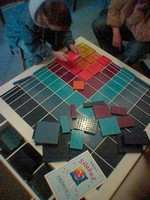
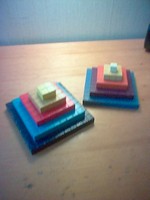


Units, tens, hundreds
Civilisation, particularly mathematics and sciences, suffered a serious stagnation because of the bad habit of writing numbers by means of alphabet signs. Not before writing numbers with their position bearing the meaning in accordance with the chosen system, decimal system in our case, did mathematics start its unforeseen way forward.
The same happens with children. In pedagogical wording “getting over number ten“ is the key issue for further understanding. There are only ten fingers. Two-digit numbers are introduced before all children are neurologically mature and for that reason they cannot clearly differentiate left and right, which further aggravates the issue.
To understand the decimal system and positional notation/writing, there is no better didactical way than this one. SilabuS UNITS, TENS, HUNDREDS in an obvious way, with no additional instructions and teaching, takes children to the situation where they themselves find the concept, the way and its meaning. SilabuS HEUREKA teaching principle, like the rest of SilabuS didactic tools, PERCEPTIBLE AND TANGIBLE MATHEMATICS, means inevitable joy and confidence in one’s own ability to understand.
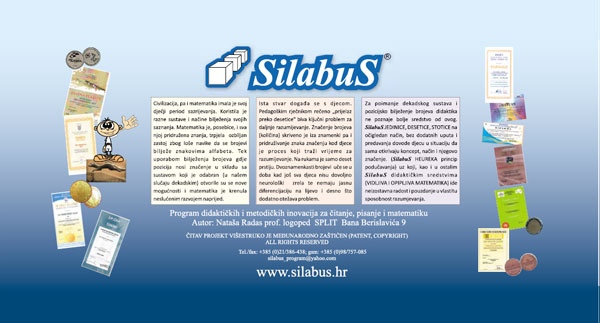

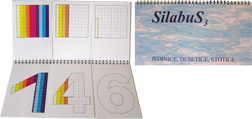
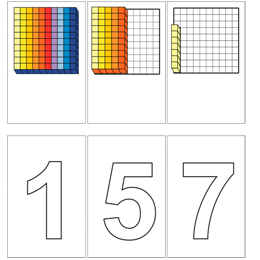
|
|